Fixing a little scratch on your car can seem daunting, but with the right approach, it can be a straightforward DIY project. This article will guide you through How To Fix A Little Scratch On A Car, from assessing the damage to achieving a professional-looking finish.
Assessing the Scratch: How Deep Is It?
Before you start, it’s crucial to determine the severity of the scratch. Is it a clear coat scratch, a primer scratch, or has it gone down to the metal? This will determine the necessary repair method. A clear coat scratch is the easiest to fix, often requiring only a polishing compound. A primer scratch, where you see a different color underneath the top coat, needs a bit more attention and likely a touch-up paint. Scratches that have penetrated to the metal require more extensive repair to prevent rust.
Clear Coat Scratches: A Quick Fix
If the scratch is only on the clear coat, you’re in luck. These are often just superficial and can be buffed out with a polishing compound.
Primer Scratches: A Little More Effort
Primer scratches require more work. You’ll need to clean the area thoroughly, apply touch-up paint, and then blend it in.
Scratches to the Metal: Preventing Rust
Scratches that reach the metal require immediate attention to prevent rust. This may involve sanding, priming, and painting.
Gathering Your Supplies: What You’ll Need
Having the right tools and materials makes the job easier and ensures a better result. For minor scratches, you might need rubbing compound, polishing pads, and microfiber cloths. For deeper scratches, you’ll need touch-up paint, primer, sandpaper, and masking tape.
Essential Tools for Scratch Repair
- Rubbing compound (for clear coat scratches)
- Polishing pads (for applying rubbing compound)
- Microfiber cloths (for cleaning and buffing)
- Touch-up paint (for primer and metal scratches)
- Primer (for metal scratches)
- Sandpaper (for smoothing the area around deeper scratches)
- Masking tape (to protect surrounding areas when painting)
- Car wash soap and water
How to Fix a Little Scratch: Step-by-Step Guide
- Wash the Area: Thoroughly clean the scratched area with car wash soap and water to remove any dirt or debris.
- Assess the Scratch: Determine the depth of the scratch as described earlier.
- Apply Rubbing Compound (for Clear Coat Scratches): Apply a small amount of rubbing compound to a polishing pad and gently rub it onto the scratch using circular motions.
- Buff the Area: After the rubbing compound has dried to a haze, buff the area with a clean microfiber cloth.
- Apply Touch-Up Paint (for Primer and Metal Scratches): Clean the area and carefully apply the touch-up paint to the scratch using a fine-tipped brush or a touch-up pen. Let it dry completely.
- Sand and Prime (for Metal Scratches): If the scratch has reached the metal, you’ll need to sand the area smooth, apply primer, and let it dry before applying touch-up paint.
- Blend the Paint: If necessary, you can use rubbing compound and a polishing pad to blend the touch-up paint with the surrounding area.
Tips for a Professional Finish
- Work in a shaded area to prevent the paint from drying too quickly.
- Apply thin coats of touch-up paint to avoid runs and drips.
- Be patient and allow sufficient drying time between each step.
“When repairing scratches, patience is key. Rushing the process can lead to imperfections and a less satisfactory result,” says John Davis, Automotive Repair Specialist at Davis Auto Body.
Conclusion: Keeping Your Car Looking Its Best
Fixing a little scratch on a car is a manageable task that can save you money and keep your vehicle looking its best. By following these steps and taking your time, you can achieve a professional-looking finish. Remember, accurate assessment and preparation are key to how to fix a little scratch on a car effectively. Don’t hesitate to contact us at AutoTipPro for further assistance. Our number is +1 (641) 206-8880, and our office is located at 500 N St Mary’s St, San Antonio, TX 78205, United States.
“Regular waxing can help protect your car’s paint and prevent future scratches,” adds Sarah Miller, Automotive Detailing Expert at Miller’s Auto Spa.




Leave a Reply